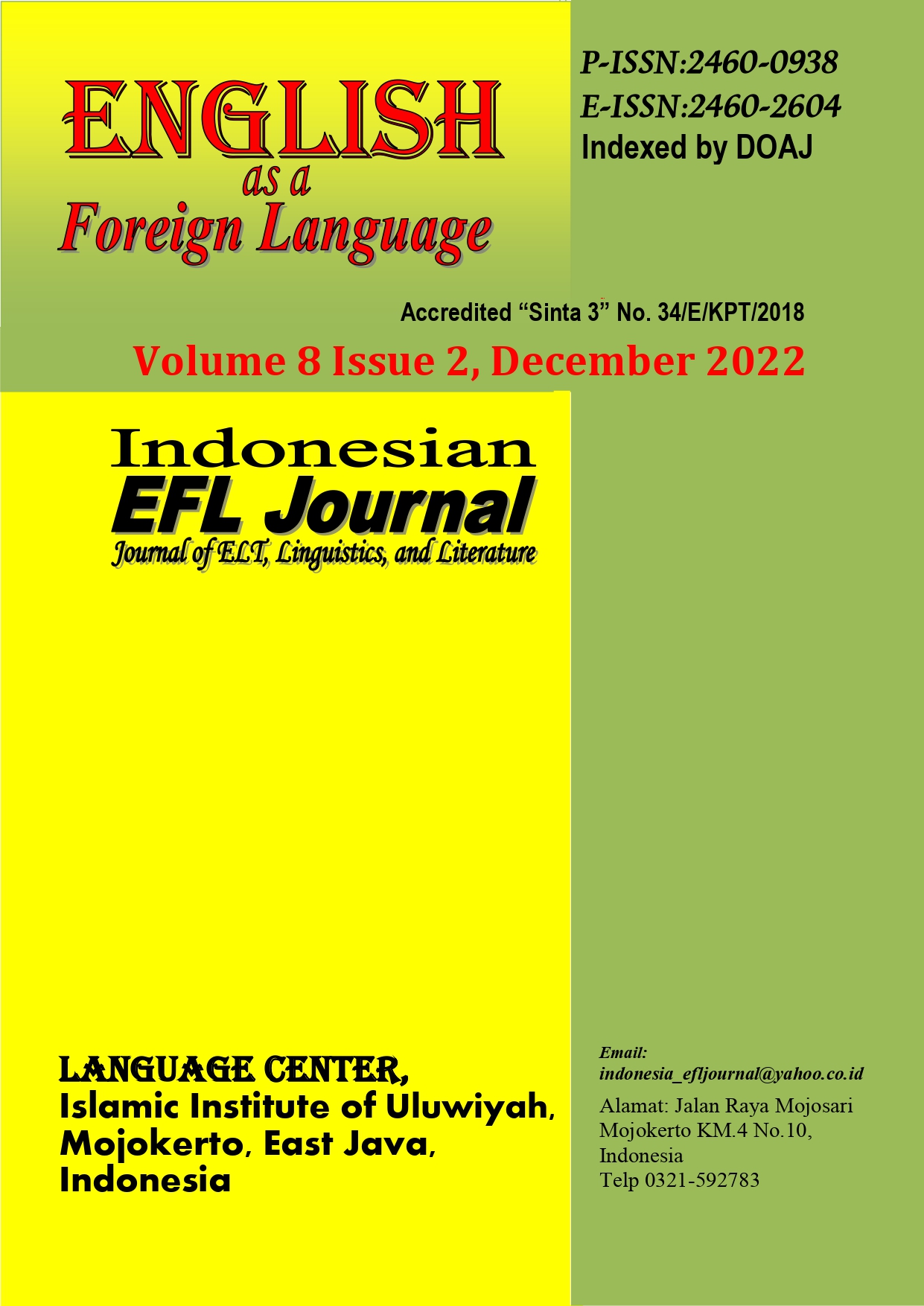‘It’s Video Era’: University Students’ Perception of Asynchronous Learning during Online Speaking Course
Abstract
Studying in university is still using asynchronous during online speaking courses due to technology development and practical consideration. This research aims to analyze the students' perception and the effect of using videos in speaking courses using asynchronous mode. This research used the quantitative research method. The instruments are used questionnaires and tests. The finding shows that the university's students have a positive perception of asynchronous learning mode, and the use of videos, as learning material, have a large effect size on the students’ ability to speak during asynchronous mode. It means the use of video can be recommended to teach speaking in the classroom.
References
Basri, M., Husain, B., & Modayama, W. (2021). University Students’ Perceptions in Implementing Asynchronous Learning During Covid-19 Era. Metathesis: Journal of English Language, Literature, and Teaching, 4(3), 263–276.
Burdette, P. J., Greer, D. L., & Woods, K. L. (2013). K-12 online learning and students with disabilities: Perspectives from state special education directors. Journal of Asynchronous Learning Network, 17(3), 65–72. https://doi.org/10.24059/olj.v17i3.327
Chang, C.-K. (2010). Acceptability of an asynchronous learning forum on mobile devices. Behaviour & Information Technology, 29(1), 23–33.
Choe, R. C., Scuric, Z., Eshkol, E., Cruser, S., Arndt, A., Cox, R., Toma, S. P., Shapiro, C., Levis-Fitzgerald, M., & Barnes, G. (2019). Student satisfaction and learning outcomes in asynchronous online lecture videos. CBE—Life Sciences Education, 18(4), ar55.
Cohen, J. (2013). Statistical Power Analysis for the Behavioral Sciences. In Statistical Power Analysis for the Behavioral Sciences. Academic press. https://doi.org/10.4324/9780203771587
Creswell, J. W. (2002). Educational research: Planning, conducting, and evaluating quantitative. Prentice Hall Upper Saddle River, NJ.
Greener, S. (2021). Exploring remote distance learning: what is it and should we keep it? In Interactive Learning Environments (Vol. 29, Issue 1, pp. 1–2). Taylor & Francis.
Ilyas, M., & Putri, M. E. (2020). YouTube Channel: An Alternative Social Media to Enhance EFL Students’ Speaking Skill. J-SHMIC: Journal of English for Academic, 7(1), 77–87.
Lowenthal, P. R., West, R. E., Archambault, L., Borup, J., & Belt, E. S. (2021). Faculty perceptions of using synchronous video-based communication technology. Online Learning, 49–78.
Luo, T., Shah, S. J., & Crompton, H. (2019). Using Twitter to support reflective learning in an asynchronous online course. Australasian Journal of Educational Technology, 35(3), 31–44. https://doi.org/10.14742/ajet.4124
Majeski, R. A., Stover, M., & Ronch, J. (2016). Making asynchronous online learning more learner-oriented: An integrated conceptual model with applications for course design and instruction. Educational Gerontology, 42(2), 109–119.
Malik, M., Fatima, G., Hussain Ch., A., & Sarwar, A. (2017). E-learning: Students’ perspectives about asynchronous and synchronous resources at higher education level. Bulletin of Education and Research, 39(2), 183–195. http://proxy.cityu.edu/login?url=https://search-proquest-com.proxy.cityu.edu/docview/1986751399?accountid=1230
Nurwahyuni, R. (2020). An Analysis of Students ’ Perception on Synchronous and Asynchronous Learning in Speaking Skill During Pandemic Covid-19. Inacelt, 4432(October), 21–22. https://e-proceedings.iain-palangkaraya.ac.id/index.php/INACELT/article/view/131
Qiong, O. U. (2017). A brief introduction to perception. Studies in Literature and Language, 15(4), 18–28.
Saeed, M. A., & Ghazali, K. (2017). Asynchronous group review of EFL writing: Interactions and text revisions. Language Learning & Technology, 21(2), 200–226.
Shang, H. F. (2017). An exploration of asynchronous and synchronous feedback modes in EFL writing. Journal of Computing in Higher Education, 29(3), 496–513. https://doi.org/10.1007/s12528-017-9154-0
Shintani, N. (2016). The effects of computer-mediated synchronous and asynchronous direct corrective feedback on writing: a case study. Computer Assisted Language Learning, 29(3), 517–538.
Vonderwell, S., Liang, X., & Alderman, K. (2007). Asynchronous discussions and assessment in online learning. Journal of Research on Technology in Education, 39(3), 309–328.
Wu, D., & Hiltz, S. R. (2004). Predicting learning from asynchronous online discussions. Journal of Asynchronous Learning Networks, 8(2), 139–152.
Copyright (c) 2022 Indonesian EFL Journal: Journal of ELT, Linguistics, and Literature

This work is licensed under a Creative Commons Attribution-ShareAlike 4.0 International License.
All rights reserved.
this publication may be reproduced, stored in a retrieval system, or transmitted
in any form or by any means, electronic, mechanical, photocopying, recording.




